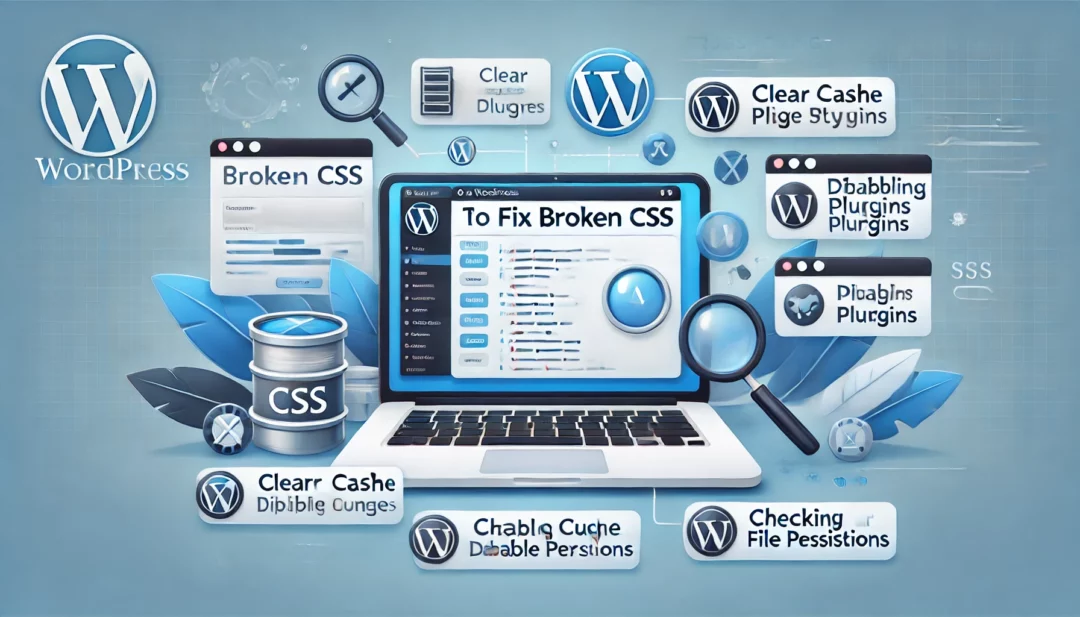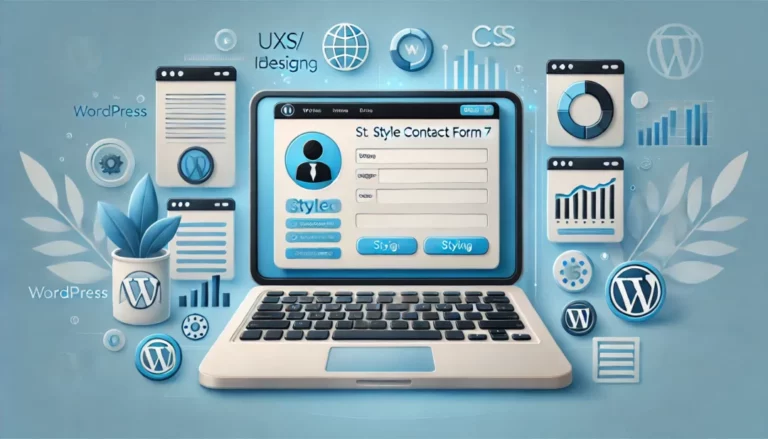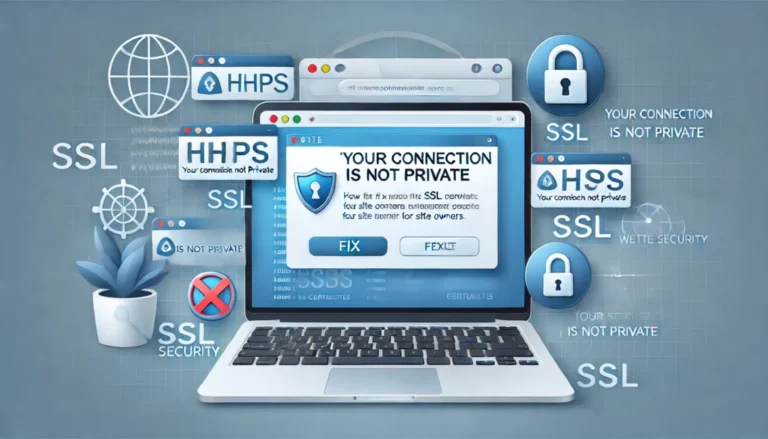
A broken CSS in your WordPress admin dashboard can disrupt your workflow and make managing your site a hassle. Whether it’s caused by plugin conflicts, caching issues, or outdated files, fixing it doesn’t have to be overwhelming. With a few targeted steps, you can restore your dashboard’s functionality and get back to managing your site smoothly.
You’ll start by clearing your browser cache to rule out temporary glitches. Then, check for plugin or theme conflicts by disabling them one at a time. If the issue persists, update your WordPress core, themes, and plugins to ensure compatibility. Finally, inspect your browser’s developer tools to identify specific errors and address them directly. These straightforward steps will help you tackle the problem efficiently.
Common Causes Of Broken CSS In The WordPress Admin Dashboard
Identifying the root cause of broken CSS in the WordPress admin dashboard is essential for implementing the correct fix. Common issues often stem from misconfigurations or compatibility problems.
Theme Conflicts
Incompatible themes can disrupt the admin dashboard’s CSS. If your theme’s code interferes with WordPress core styles, it creates display errors in the admin panel. Switching your current theme to a default WordPress theme like Twenty Twenty-Three can help verify if the theme is causing the issue.
Plugin Compatibility Issues
Plugins designed with outdated code or clashing styles can break the layout. If a plugin injects custom CSS into the admin dashboard or overrides native styles, errors occur. Deactivate all plugins, then reactivate them one by one to pinpoint the problematic plugin. Start with recently added or updated plugins for efficiency.
Caching Problems
Outdated cached files can prevent CSS changes from loading properly. If browser or site-level caching tools like WP Super Cache or W3 Total Cache are active, they might save an older CSS version, breaking your dashboard’s design. Clear your browser cache and website cache, then reload the admin dashboard to check for resolved errors.
Outdated WordPress Core
An outdated WordPress core can cause compatibility issues with themes and plugins, affecting the admin panel’s CSS. Regular updates ensure alignment with the latest browser standards, security patches, and coding practices. Update to the latest WordPress version through the dashboard or manually via FTP to resolve the conflict. Always back up your site before proceeding.
Troubleshooting The Issue
Resolving broken CSS in the WordPress admin dashboard involves identifying and addressing errors systematically. This section outlines steps to pinpoint the problem and restore functionality.
Checking Browser Developer Tools
Use browser developer tools to detect CSS-related issues. Open the WordPress dashboard and press Ctrl + Shift + I (Windows/Linux) or Cmd + Option + I (Mac). Navigate to the Console tab to view JavaScript errors or warnings. Pay attention to errors like “Failed to load resource” or “CSS not found,” indicating missing or misconfigured files.
Inspect the Network tab to confirm if CSS files are loading correctly. Look for red-highlighted lines under “Status” to identify problematic files. Analyze these files to check for incorrect file paths, missing resources, or server errors. If errors persist, proceed to isolate plugins or themes.
Identifying Faulty Plugins Or Themes
Deactivate plugins or revert themes to test compatibility. Start by switching to a default WordPress theme like Twenty Twenty-Three under Appearance > Themes in the admin dashboard. If CSS issues resolve, the original theme may be incompatible.
Next, disable all plugins under Plugins > Installed Plugins and refresh the dashboard. Reactivate plugins one at a time, checking the dashboard after each activation. Identify plugins interfering with the CSS and consider replacing or updating them. Ensure all themes and plugins are sourced from reputable developers to minimize conflicts.
Inspecting Custom CSS Code
Review custom CSS files or inline styles for errors. Access the Additional CSS section under Appearance > Customize to check for typos, invalid properties, or accidental overrides. Use a CSS validator like W3C CSS Validation Service to confirm syntax accuracy.
If the issue stems from external modifications, review the style.css file in your WordPress theme directory. Access it via an FTP client or cPanel File Manager. Restore an original backup or remove suspicious code if you detect edits causing conflicts. Regularly back up these files to safeguard against accidental changes.
Fixing Broken CSS Step By Step
Addressing broken CSS in the WordPress admin dashboard involves systematic steps. Follow these detailed instructions to restore functionality and ensure compatibility.
Deactivating All Plugins
Deactivate all plugins to identify potential conflicts. Navigate to Plugins > Installed Plugins in your WordPress admin bar. Use the Bulk Actions dropdown to select Deactivate, then confirm. Check the dashboard to see if the CSS issue resolves.
If the problem disappears, reactivate plugins one by one to pinpoint the incompatible one. Focus on recently installed or updated plugins. Replace or update conflicting plugins to avoid recurring issues.
Switching To A Default Theme
Switch to a default WordPress theme like Twenty Twenty-Three to test theme compatibility. Go to Appearance > Themes, hover over the default theme, and click Activate. Reload the admin dashboard to observe any changes.
If this restores the CSS, the issue lies in your custom theme. Consider updating, debugging, or contacting the theme developer for assistance. Always back up your site before making theme changes.
Clearing Cache And Browser Data
Clear your browser cache and site-level caching systems to eliminate outdated files. Access the browser settings, find the Clear Browsing Data option, and ensure Cached Images and Files is selected. For site-level caches, use caching plugins or hosting control panels to clear the cache.
Refresh the admin dashboard after clearing caches to verify if CSS issues are resolved. If you’re using a Content Delivery Network (CDN), clear the CDN cache as well to ensure updated files load correctly.
Advanced Solutions For Persistent Issues
When basic troubleshooting fails, deeper intervention can resolve stubborn CSS issues in your WordPress admin dashboard. Explore advanced methods to ensure a fully functioning interface.
Restoring A Backup Of Your Site
If recent updates or changes caused CSS problems, rolling back to a previous backup can help. Use the tools offered by your hosting provider or a backup plugin to restore your site.
- Access Backup Settings: Log into your hosting account or WordPress dashboard and locate the backup utility, such as Jetpack or UpdraftPlus.
- Choose A Backup Date: Select a backup created before the issue began. Double-check the timestamp for accuracy.
- Restore The Backup: Click the restore option, and let the process complete. Avoid interrupting the restoration to prevent incomplete files.
Always verify that your backup is complete and free of errors before proceeding.
Manually Replacing Core Files
Manually replacing WordPress core files eliminates corrupted or altered files often responsible for CSS issues. Use this method cautiously to avoid file mismatch.
- Download A Fresh WordPress Copy: Visit wordpress.org and download the latest version of WordPress.
- Access Your Site’s File System: Connect via FTP using tools like FileZilla or cPanel’s File Manager.
- Replace Affected Core Files: Extract the WordPress zip file, and upload the
wp-adminandwp-includesfolders to replace the existing ones. Don’t overwrite thewp-contentfolder to preserve themes and plugins. - Confirm Changes: Clear caches and reload your admin dashboard to verify the fix.
Perform incremental replacements if unsure about which files are corrupted, starting with core folders.
Debugging With wp-config.php
Activating debugging flags in wp-config.php helps identify CSS-related issues by logging detailed errors.
- Access wp-config.php: Open your WordPress files through FTP or your hosting panel’s file manager.
- Enable Debugging: Add the following lines before the “That’s all, stop editing!” comment:
define( 'WP_DEBUG', true );
define( 'WP_DEBUG_LOG', true );
- Review Debug Log: Navigate to
wp-content/debug.logto analyze error messages. Look for references to CSS files or plugin conflicts. - Disable Debugging: Once resolved, set the WP_DEBUG value to false to avoid exposing error logs.
Focus on troubleshooting entries related to your dashboard for targeted fixes.
Preventing Future CSS Breakage
Avoiding future CSS issues in your WordPress admin dashboard ensures smooth site management. Implement these proactive strategies to minimize problems.
Regular Updates Of Themes, Plugins, And WordPress Core
Keeping your WordPress setup updated reduces compatibility issues. Update your themes, plugins, and WordPress core regularly because outdated versions increase the risk of CSS conflicts. Automatic updates simplify this process, but monitor update logs for potential changes that might affect your site. Always back up your website before applying new updates to avoid losing data in case of errors.
Testing Changes In A Staging Environment
A staging environment helps you test changes safely. Set up a duplicate site on your hosting provider, ensuring it mirrors the live environment. Apply updates, new plugins, or custom CSS modifications here to verify stability before pushing changes live. If your hosting plan supports one-click staging, utilize that feature for efficiency. Testing in isolation prevents unexpected CSS breakage on your main site.
Using Reliable Plugins And Themes
Reliable plugins and themes from trusted sources reduce the likelihood of code errors. Choose items explicitly marked as compatible with your WordPress version. Check user reviews and support forums to identify potential issues. Avoid installing too many plugins at once since conflicts between them often cause CSS errors. Focus on using tools maintained with frequent updates and strong developer support.
Conclusion
Fixing broken CSS in your WordPress admin dashboard might seem overwhelming, but with a structured approach, it’s entirely manageable. By addressing potential issues like plugin conflicts, outdated files, or caching problems, you can restore functionality and maintain a seamless workflow. Don’t forget to utilize tools like browser developer tools and debug logs for deeper insights when needed.
To ensure long-term stability, prioritize regular updates, test changes in a staging environment, and rely on trusted themes and plugins. Proactive maintenance not only prevents future CSS issues but also keeps your WordPress site running smoothly. With these strategies, you’ll be well-equipped to handle any CSS challenges that come your way.
Frequently Asked Questions
1. What causes broken CSS in the WordPress admin dashboard?
Broken CSS in the WordPress admin dashboard is often caused by conflicts with plugins or themes, outdated WordPress core files, caching issues, or errors in custom CSS.
2. How can I fix broken CSS in the WordPress admin dashboard?
You can fix broken CSS by clearing your browser and site-level caches, disabling plugins and themes to identify conflicts, updating your WordPress version and extensions, and using browser developer tools to spot and fix issues.
3. How do I use browser developer tools to troubleshoot CSS issues?
Open your browser’s developer tools, go to the Console to check for JavaScript errors, and use the Network tab to identify loading issues. Inspect styles to debug CSS directly.
4. Should I deactivate plugins to resolve CSS issues?
Yes, deactivate all plugins and reactivate them one by one to identify which plugin is causing the problem. Focus on recently installed or updated plugins.
5. What should I do if clearing the cache doesn’t work?
If clearing the cache doesn’t resolve the issue, try switching to a default WordPress theme or manually replacing WordPress core files via FTP to fix potential corruption.
6. Can outdated WordPress versions cause CSS issues in the admin dashboard?
Yes, outdated WordPress versions can lead to compatibility problems with themes and plugins, breaking CSS. Regular updates are essential to maintain compatibility.
7. How can I prevent future CSS issues in WordPress?
To prevent CSS issues, keep WordPress, plugins, and themes updated. Test changes in a staging environment, use reliable plugins/themes, and avoid excessive plugin installations.
8. What is the safest way to debug CSS issues in WordPress?
The safest way is to enable debugging in wp-config.php and review the debug logs for errors. Always back up your site before making changes.
9. How do I restore my WordPress site from a backup?
Access your hosting provider’s backup settings or use a backup plugin. Choose a restore point, confirm the restoration, and test your site to ensure the issue is resolved.
10. When should I seek professional help for CSS issues?
If basic troubleshooting fails or you’re uncomfortable making advanced changes, it’s best to consult a WordPress developer to avoid potential site damage.






